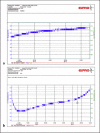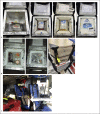Blood Product Supply for a Helicopter Emergency Medical Service
- PMID: 35082564
- PMCID: PMC8740152
- DOI: 10.1159/000519825
Blood Product Supply for a Helicopter Emergency Medical Service
Abstract
Background: Long patient transport times to trauma centers are a well-known problem in sparsely populated regions with a low hospital density. Transfusion of red blood cell concentrates (RBC) and plasma improves outcome of trauma patients with severe bleeding. Helicopter emergency services (HEMS) are frequently employed to provide early advanced medical care and to reduce time to hospital admission. Supplying HEMS with blood products allows prehospital transfusion and may help to prevent exsanguination or prolonged hemorrhagic shock. We have investigated the maintenance of blood product quality under air transport conditions and the logistical steps to introduce a HEMS blood depot into routine practice.
Methods: A risk analysis was performed and a validation plan developed. A special, commercially available transport container for blood products was identified. Maintenance of temperature conditions between 2 and 6°C in the box were monitored at ambient temperatures up to 35°C over 48 h. Quality of blood products before and after helicopter air transport were evaluated including (1) for RBCs: hemoglobin, hematocrit, hemolysis rate; (2) for thawed plasma: aPTT, INR, single clotting factor activities. The logistics for blood supply of the regional HEMS were developed by the transfusion service of the Greifswald University Hospital in collaboration with the in-hospital transport team, the HEMS team, and the HEMS operator.
Results: The transport container maintained a temperature below 6°C up to 36 h at 35°C ambient temperature. Vibration during helicopter operation did not impair quality of RBC and thawed plasma. To provide blood products for HEMS at least two transport containers and an additional set of cooling tiles is needed as the cooling tiles need a special temperature priming over 20 h. The two boxes were used at alternate days. To reduce wastage, RBCs and thawed plasmas were exchanged every fourth day and reintegrated into the blood bank inventory for further in-hospital use.
Conclusions: Supplying HEMS with RBCs and plasma is feasible. Helicopter transport has no negative impact on blood product quality. The logistic challenges require close collaboration between the HEMS team and the blood transfusion service.
Keywords: Clotting factors; Helicopter emergency medical service; Thawed plasma; Transfusion therapy.
Copyright © 2021 by S. Karger AG, Basel.
Conflict of interest statement
M.B. and K.-C.T. are members of the scientific working group of the DRF Luftrettung. M.R., F.R., J.B. are employees of the DRF Luftrettung. K.S. received research funding from Immucor, traveling support from SOBI and consultant fees from Aspen. A.G. received research funding from Ergomed, Boehringer Ingelheim, Rovi, Sagent, Macopharma, Portola, Biokit, Blau Farmaceutics, Prosensa/Biomarin, DRK-BSD NSTOB, DRK-BSD Baden-Württemberg/Hessen, travel support, speakers and consulting fees from Roche, GTH e.V., Sanofi-Aventis, Macopharma, Chromatec, Instrumentation Laboratory, Bayer Vital and Aspen. B.H., G.J., M.H., T.W., K.H. declare no conflict of interest.
Figures


References
-
- Vulliamy P, Thaventhiran AJ, Davenport RA. What's new for trauma haemorrhage management? Br J Hosp Med (Lond) 2019;80((5)):268–73. - PubMed
-
- Kauvar DS, Lefering R, Wade CE. Impact of hemorrhage on trauma outcome: an overview of epidemiology, clinical presentations, and therapeutic considerations. J Trauma. 2006;60((6 Suppl l)):S3–11. - PubMed
-
- Kotwal RS, Scott LLF, Janak JC, Tarpey BW, Howard JT, Mazuchowski EL, et al. The effect of prehospital transport time, injury severity, and blood transfusion on survival of US military casualties in Iraq. J Trauma Acute Care Surg. 2018;85((1S Suppl 2)):S112–21. - PubMed
LinkOut - more resources
Full Text Sources

